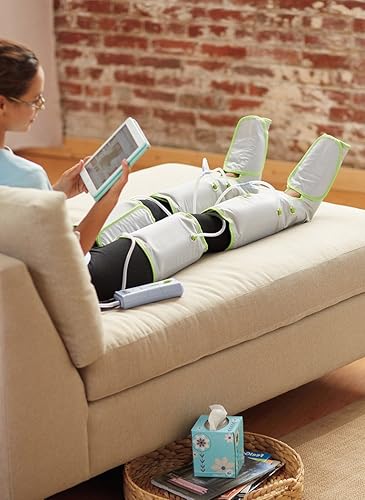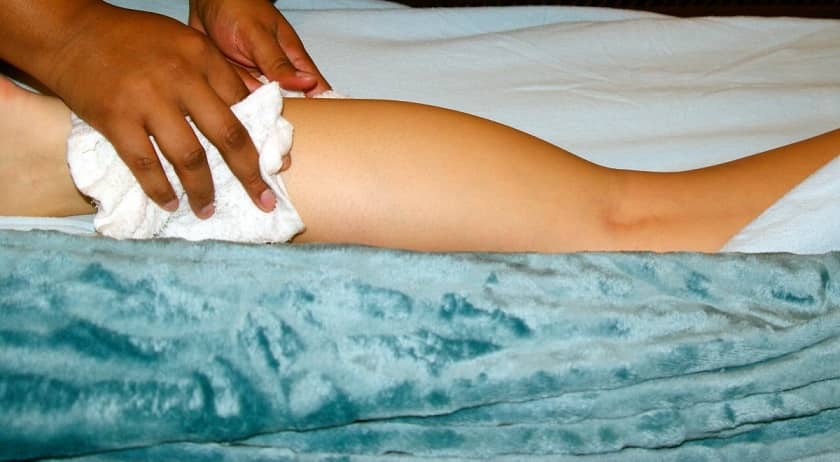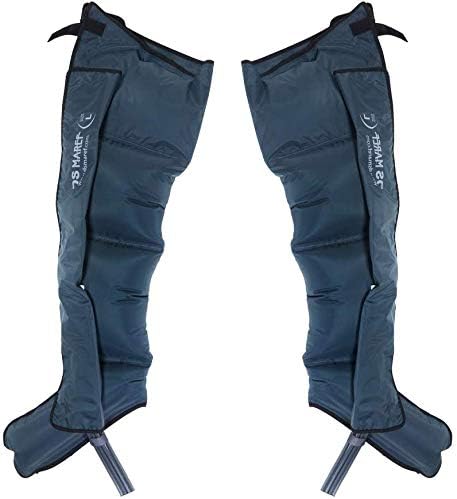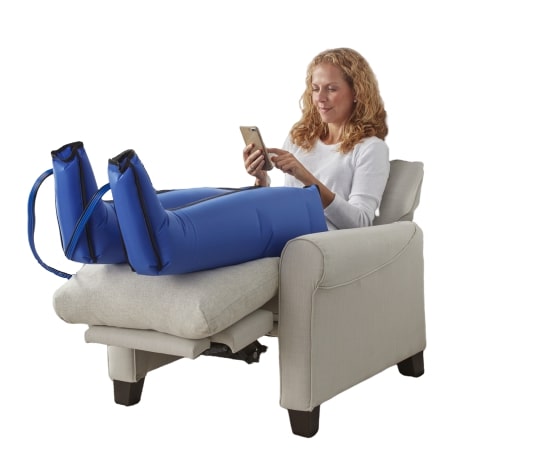Author: Jennifer Austin (BSc MS)
The use of compression pumps for lymphedema has a long history.
And depending on who you ask, you will get differing opinions on whether these pumps are good or bad for lymphedema.
In this article we will take a closer look at the evidence for using compression pumps (aka sequential compression devices) for lymphedema.
Hopefully this will leave you better informed before deciding on this type of treatment for lymphedema.
What Are Sequential Compression Devices For Lymphedema?
A sequential compression device for lymphedema is used to deliver intermittent pneumatic compression (IPC).
The device has sleeves containing several chambers, which inflate to apply pressure to the limb the device is fitted to.
The chambers then deflate, and can be set to inflate/deflate at different intervals and patterns, hence the name intermittent pneumatic compression.
In the case of someone experiencing lymphedema, this is used to move the lymph fluid from the affected limb, with the aim of reducing swelling.
For example in lower limb lymphedema such a device can be used to move the fluid back up to the functioning lymph nodes located in the groin.
The body can then process the fluid normally.

When To Use Lymphedema Pumps?
Lymphedema pumps work great when used correctly, and in conjunction with other approaches.
Firstly, it is recommended that manual lymph drainage is performed first to prepare the lymphatic system to receive the lymph fluid.
This can be done by a therapist, a caregiver, or the person.
Also, it has been observed in studies that better results in swelling reduction were achieved when the compression pump was combined with other therapies.
These include manual lymphatic drainage, compression garments, and self massage.

Other studies also demonstrated that continuing with the pump therapy, and supporting this by wearing a pressure/compression garment afterwards, was a beneficial approach in maintaining initial swelling reductions.
Effectiveness of compression pumps used on the various stages of lymphdema has not been studied in any great detail.
The more advanced your lymphedema is however, the likelihood is the you will see less and less results from such devices.
Stages 0 to 1 – You will stand a better chance of seeing positive results from such devices.
Stage 2 – You may see benefits from these devices, however this will need to be done in conjunction with other steps as discussed.
Stage 3 – There will likely be little benefit to using such devices. Permanent changes to the affected body area will have taken place at this point. Also you will likely struggle to find compression pump sleeves which will fit the affected area of the body.
However every person is different, so always seek advice from your lymphedema therapist first.

However there are also situations when you should not use such pumps, which we will discuss below.
You should ideally always speak to your doctor or lymphedema therapist before using such a machine.
Are Compression Devices Safe To Use For Lymphedema?
If used correctly, these devices are generally recommended as safe to use with lymphedema.
There have been reports in the past that such devices can force excess fluids into the surrounding tissues, therefore creating more problems.
However, the problems in the past with such pumps can often be attributed to the old style “squeeze and hold” pumps.
Studies on these old style pumps can often unfairly portray compression pumps in terms of their effectiveness for lymphedema.
For example, it is commonplace that in studies looking at the efficacy of such ‘simple pump’ devices, there is often no mention of the type of pump used.
Also the more traditional pumps tended to apply pressure way in excess of the pressure indicated in the device’s settings.
One study demonstrated significant differences in the pressure applied by two different compression pump systems, despite identical pressures being set.
This is significant when considering that lymphatic structures may be damaged if pressures applied in therapy are too high.
Pressures applied in lymphedema treatment must be mild, with some experts recommending pressures no higher than 40 mm/Hg.
Fortunately technology has come a long way, and the more calibrated and modern compression pumps are more accurate in terms of pressure settings.
However, there is still the potential for the development of fibrotic cuff, which is where the protein-rich lymph fluid is forced to the top of the limb where it pools.
This is typical in compression pumps which only cover a portion of the limb.
For this reason it is important to take steps to move the lymph fluid into an area of the body where it can enter the lymph system, and be processed by the body.
For example in the legs you may wish to manually massage fluid from the top of the leg to the groin area (assuming the lymph nodes in that area are still intact), or use a compression device which covers the area .
Lying flat during compression work on lower limbs may also open the groin region up, and allow for better flow of lymph fluid.

What Does The More Modern Research Say On Their Use?
A 2008 study states that IPC is an effective treatment option for reducing swelling in legs.
This was also confirmed in a study printed in The Foot Journal in 2000.
A more recent study in 2012 stated that “Intermittent pneumatic compression (IPC) therapy is an effective modality to reduce the volume of the lymphedematous limbs alone or in conjunction with other modalities of therapy such as decongestive therapy.”
Studies conducted by Andrzej Szuba (Stanford/Aurora Centre for Lymphatic and Venous Disorders) have demonstrated swelling volume reductions of up to 51% in patients who were given IPC.
What Are The Advantages of Using Such Devices For Lymphedema?
For lymphedema patients, the most obvious benefit is a reduction in swelling in the area in which the device is used.
You will find as a result you have improved mobility, more energy, more confidence, and better sleep quality.
Secondary benefits include improvements in pain and stiffness, strengthened immune system, reduced stress and increased endorphins and amino acids.
You may find you are less reliant on institutional based professional therapy.

Can Compression Pumps Be Used For Arm Lymphedema?
Yes, this has been demonstrated as an effective approach through various studies.
It is widely considered that the best treatment for arm lymphedema is actually a combination of manual decongestive therapy, compression bandages and the use of a compression pump.
What Are The Best Pump Features and Settings To Use For Lymphedema
Firstly, a study by Bergan, Sparks and Angle demonstrated that the more chambers a device has, the greater the reduction in lymphdema.
This study demonstrated that the greatest benefits come from a device with more than three inflation chambers.
It is generally recommended that the pump it set to massage in sequence, inflating from the lowest point on the limb, moving up the leg or arm (towards the torso).
Cycles of around 30 seconds are recommended compared to cycles of 60 seconds or more (as this can damage the superficial lymphatics).
Also, pressures should not be set higher than 60mmHg.

Other recommendations are that pumps should not be applied over compression bandaging or compression stockings.
Also they should be applied for about two hours in the morning, and two hours at night during treatment (before bed if possible). Then as needed for continued edema reduction.
A further study by Grieveson suggested that the best results (in terms of a reduction of swelling) came from pressure settings of 40 mmHg, with a 10 second deflation time and 15 second inflation time.
Positive results were seen also from 30 mmHg pressure with a 35 second deflation time and 5 and 45 second inflation times.
Lower pressures combined with shorter inflation/deflation times appears to be a more efficient approach than higher pressures and long inflation/deflation times.
When NOT to Use Pumps For Lymphedema & Contraindications
It is suggested that you should not use a pump if you have any of the following:
- Edema throughout your entire body
- A blood clot
- An active infection
- Renal (kidney) failure
- Active cancer
- Congestive heart failure
- Deep vein thrombosis within the past year
- Cellulitis or acute infection of the affected limb
- Respiratory insufficiency
Pumps are also not normally recommended for babies, or children under age six.

Can You Use Compression Pumps With Ulcers and Wounds?
Such pumps can be used on patients with venous ulcers or open wounds. However, be sure as there are no signs of infection or cellulitis.
The wound/ulcer area must be covered with a sterile dressing material to absorb any fluid forced out of the area.
If an infection occurs you should never use such a pump, as this could move the infected fluid back into the body.
What Is The Best Way To Use Sequential Compression Pumps for Lymphedema?
Sequential compression devices are most effective when used in conjunction with lymphatic drainage massage.
Healthline.com have written a handy step by step guide for preparing your body for use a lymphedema compression pump.
You should manually clear the trunk and any proximal areas prior to, during, and after pumping.
This provides a reservoir for lymph moving out of the limb. Pumping can be dangerous if fluid is not transported to a cluster of functioning lymph nodes.
Once you have prepared the limb to accept the transport of lymph fluid, a compression device can be used to move the fluid from the extremity (farthest point on limb away from the body) back up to the lymph nodes in the torso.
For example moving fluid from the lower limb to typically the groin area would be your goal for lower limb lymphedema (assuming the nodes in your groin are still intact/functioning).

Some users report better results from wearing such machines when lying down. This is particularly important for leg and foot lymphedema. This makes the transport of fluid back up the leg easier.
Also if you are flat, the groin area is more open, and it makes for easier transport of fluids from the legs to the groin and reduces the risk of pooling at the top of the legs.
For this reason you may find better results from either lying down, or sitting in a recliner chair which also raises the feet.
It is also recommended that any abdominal lymphatics are cleared first before a pump is used. This will reduce the risk of developing genital lymphedema.
Don’t forget to apply a pressure garment in the morning to prevent gravity from pulling fluid back down into the limb.
Which Lymphedema Pumps Should You Use For Sequential Compression At Home?
Always aim for a pump which provides a pump pressure profile that more closely emulates the gentle stretch and release motions of manual lymphatic drainage therapy (MLD). This will reduce risk of damage to fragile superficial lymphatics.
Ensure you choose a pump which can apply pressures of 30 or 40 mmHg, with inflation and deflation times of around 80 seconds for maximum benefits.
Ensure the pump has at least four chambers, and covers as much of the limb as possible in terms of the sleeve length.
You can also check out our article on the Best Leg Compression Machines For Lymphedema by clicking here.
Conclusion
This concludes our article on compression pumps for Lymphedema.
Have you used sequential compression devices for Lymphedema? We would love to hear your experiences in the comments section below.
We hope you found this article informative and welcome you to check out more at lymphedemalifeline.org.
Disclaimer – The information on this website is for informational purposes only. Lymphedemalifeline.org and it’s staff, writers, etc. assumes no responsibility for any consequences arising from any use made of, or any reliance on, the information contained on this website.


There is a lot of misinformation around about this form of therapy, so I was pleased to discover this article
Can I purchase this product if I know my sleeve size
After using the leg pump a few times, I found that compression socks controlled the foot and leg swelling more than the IPC device. The compression socks do not have to be overly tight to ensure even distribution of the leg and foot tissue. Although the swelling is under control, I have chronic tingling and numbness in the affected lower areas. I am looking into this problem.